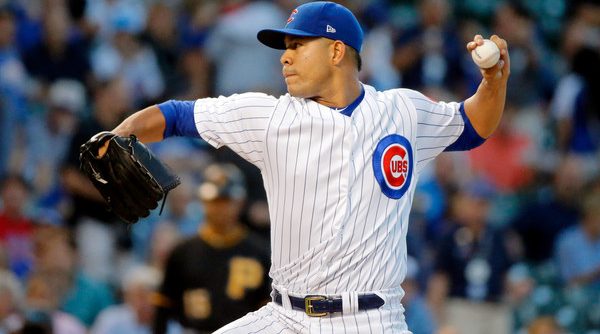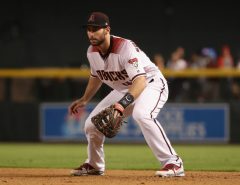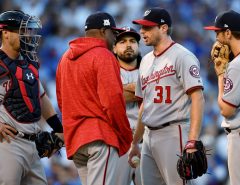The Nationals are cruising to their fourth division title in six years. Most importantly, they have played well with an MLB-high 12 men on the disabled list. On the night Jayson Werth and Max Scherzer came off the disabled list, they clown-pounded the white-hot Marlins. They followed that up by completing the sweep with Vintage Strasmas: Stephen Strasburg pitching a complete-game shutout in which he also homered. Trea Turner is back and running all over the bases. This team is getting healthy, and game one against the Marlins is a reminder of what this lineup can do when healthy. Regular season success is nice, but the playoffs is what matters. Thomas Boswell put it so eloquently, as emblazoned on the walls of the Hall of Fame:
“Baseball is really two sports — the summer game and the autumn game. One is the leisurely pastime of our national mythology. The other is not so gentle.”
Nationals fans are all too familiar with that not-so-gentle potion of the season. However, this might be the best team we have ever had in the National’s Capital. In order to prove that, we need to get it done in the playoffs. The Nationals sit locked in as the second seed: 11.5 games behind the Dodgers, 7.5 ahead of the Central-leading Cubs. Our NLDS opponent will certainly be the Central winner, and the Cubs and Brewers are separated by just 3.5 games. A look at each:
Brewers (season series tied 3-3, 1 game remaining): Surprisingly, the Brewers are just 18th overall in MLB in oWAR (Fangraphs) at 13.9. That trails also-rans in Detroit and Cincinnati, and a laughable train-wreck in the Mets. They’re 20th in average (.249) and 19th in OBP (.320). They have the highest K-rate in MLB at 25.9%. This is an all-or-nothing lineup, as they are fifth in the Majors in home runs, at 188. They currently have four 20-homer players, lead by Travis Shaw with a slash-line of .280/.352/.533 and 27 HR. Despite their overall high-K numbers, they have several players with above-average OBPs in Shaw, Domingo Santana, Eric Thames, and Ryan Braun. But Thames, Villar, Keon Broxton, and Santana have struck out 143, 124, 156, and 147 times, respectively.
The Nationals went into Milwaulkee and dropped the first two games of the series before claiming the third. This is not necessarily a “playoff preview.” The Nationals entered the second game of the series playing 13 games in 12 days, with two road trips and no travel days. As Nats fans are aware, the all-or-nothing offenses do not work in the playoffs. More often than not, they’re end up in the “nothing” category.
The Brewers pitching is better than expected. Jimmy Nelson just stifled the Nationals’ near-full lineup, as he and two relievers combined to pitch a three-hit, 17 K gem. Nelson is one of the better pitchers no one really talks about. He has a 3.05 FIP, while averaging 10.9 K/9 and 2.8 BB/9. Zach Davies held the Nationals lineup to two runs over seven innings, with 17 ground ball outs. Over his last 13 starts, Davies has a 2.64 ERA, and a 1.23 ERA against the Nationals on the season. In fact, Davies has been an under-the-radar Nat killer, going 3-0 in his career with a 2.39 ERA against the Curly W. Chase Anderson has been solid as well, albeit missing six weeks with an oblique injury. The rest of their rotation is a question mark. Rookie Brandon Woodruff has impressed over his first three starts, despite his 6.4 K/9 and 4.32 BB/9. Sean Newcomb had a similar start to his career, and currently has a 4.68 FIP. Junior Guerra followed up last year’s break out with a 4.96 ERA, and Matt Garza has not been good in three years.
Their bullpen is a bit enigmatic. Josh Hader (no relation to Bill) has helped solidify the back-end of the Crew’s bullpen. Corey Knebel has been fantastic — averaging 15.1 K/9 with a 97.2 MPH fastball. They also have deadline acquisition Anthony Swarzak averaging 14 K/9 but giving up two homers per. The rest of their pen is average, at best. Their biggest weakness is walks. No one has less than 3.5 BB/9; Knebel is averaging 4.9 while Hader is at 5.6. If the Nationals can be patient, they can get to this pen.
Cubs (Nats won season series 4-3): After 108 years of failure, the Cubs have switched from loveable losers to the team no one wants to face in the playoffs. Led by the “Weird Wuss,” the Cubs have put their early season struggles behind them. On July 11th, the Cubs were 43-45, 5.5 games behind the Brewers. Since then, only the Dodgers have posted a better record than their 31-15 pace. They are currently fourth in overall WAR, at 22.5 just behind the Nationals’ 24.0. They take a lot of walks—their 9.8% rate is second behind the Dodgers. They will strike out too, with a K rate at 22.2% good for 12th highest. Their fearsome lineup is led by Kris Bryant and Anthony Rizzo. Both have few weaknesses at the plate, boasting good OBPs, (.409 and .399 respectively), low strike-out rates (18.6% and 12.6% respectively), and great slugging (.535 and .539 respectively). But that is not exactly news. Rizzo and Bryant are fantastic players.
The rest of the lineup is good, but has some holes. Javy Baez is a fun player to watch but has a bit of Danny Espinosa in him: good defensively, good baserunner, 20 HRs, to accompany a 5.9% BB rate and 28.3% K-rate. Willson Contreras crushed the Nationals this year with five home runs, hitting .375/.400/1.000 in seven games, and is one of the better defensive catchers in the game. Kyle Schwarber has struggled this year, but has still managed to slug 24 homers. Jon Jay doesn’t have a lot of power, but gets on base well, with a .381 OBP. The rest of the Cubs offensively are mostly negative oWAR, per FanGraphs. Jason Heyward has been a colossal bust. The seeming key to the Cubs lineup is to limit the damage caused by the lineup outside of Rizzo and Bryant.
Their starting pitching has come on as of late as well, especially Jake Arrieta, posting a 1.69 ERA over his last 11 starts. Though,the last time the Nationals faced Arrieta, Turner and Michael A. et al ran wild, leading to Miguel Montero getting cut for being an idiot. Kyle Hendricks has a 2.41 ERA in the month of August after inconsistency and injuries. Behind them is some question, however. Jon Lester (2.63 postseason ERA) had been on the DL with a lat strain and shoulder fatigue. Prior to going on the DL, he struggled with a 5.87 ERA. He did not fare well in his first game back either: 5 IP, 4 ER, 3 HR. Jon Lackey has a 4.74 ERA, although he has been better lately, posting a 3.90 ERA over his last 10 starts. Trade-deadline acquisition Jose Quintana has shown good peripherals: 10.9 K/9, 2.9 BB/9, 1.192 WHIP. However, he has continued his trend with the White Sox: his ERA is 4.50 and his FIP is 4.02. Initial returns have to be less than what Theo Epstein was looking for.
The Cubs bullpen has the same problem, seemingly, as the Brewers: high-K, high-BB. While Wade Davis has been fantastic: 28/28 in save opportunities, 2.12 ERA, 11.4 K/9; he does walk a lot of batters at 4.8/9. The Nationals gave Davis a scare, posting four runs in the 9th at the end of June 26th contest the Cubs ultimately won 5-4. Carl Edwards Jr. strikes out 12.9 per 9, but walks 5.5. The Nationals got to him a few days after Davis, scoring three runs and taking the lead on June 29th (before Blake Treinen blew it in the 9th). Pedro Strop, and his stupid crooked hat, has really struggled lately, posting a 6.00 ERA in August. He also broke Turner’s wrist. Justin Wilson has really struggled since coming over from the Tigers, walking 7.4 per 9.
In the Cubs’ three wins against the Nationals, they have victimized Blake Treinen, Matt Grace, and Edwin Jackson — three pitchers they are unlikely to see in the post season. The Nationals’ four wins have been over Arrieta, Lackey (twice), and Hendricks—who will most likely be part of the NLDS rotation. The Nationals also have this tidbit of clubhouse material (if there is such a thing).
Who is the better matchup? The Nationals’ offense has really struggled against the Brewers pitchers this season. They pasted Michael Blazek — who hasn’t pitched since — for eight runs, leading to a 15-2 shellacking. Their other win at Nats Park, Nelson gave the lineup fits again—7 IP 2 ER 10Ks. They took over the game against middle relievers Jared Hughes and Jacob Barnes. It seems like the Brewers have the Nationals’ number. They hit Gio well in one game, beat Jackson in another, and our lineup was rendered useless in their third win, even though Roark was fantastic.
As for the Cubs, the Nationals have done well against their pitchers and relievers they are likely to see in the playoffs. The Nats hit Davis, Edwards, and Strop well. They have held Rizzo in check (.646 OPS), while Bryant did well (.851 OPS). Contreras has gone full Freddie Freeman against us. The Cubs did not do much against the pitchers they’re likely to see in the NLDS. Stephen Strasburg went 7, striking out 13 in a win. Tanner Roark out dueled Hendricks in a win. Max was Max against them: six shut-out innings with six Ks.
Even though the Brewers have the better numbers against Washington, it is really difficult to pick against the defending champion. The Cubs boast that “mystique” now. Regular season means nothing in the playoffs — and Max, Stras, Gio, and Tanner look very good against the high-strikeout Brewers lineup.
Tags: Chicago Cubs, Milwaukee Brewers, Nationals, Nats, Washington Nationals




Leave a Reply